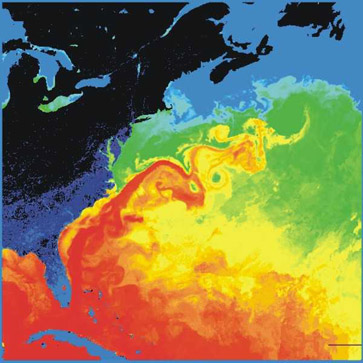
I’ve written about studies that look into the impact of climate on the Atlantic Meridional Overturning Circulation (AMOC). This is perhaps better known to the wider public as the Gulf Stream.
The plot of the 2004 movie, The Day After Tomorrow, is that the Atlantic Ocean Circulation which carries warm water North suddenly stops and plunges the entire Northern Hemisphere into an Ice Age almost overnight… er yes, well that is just a movie. What is actually going on with the Atlantic circulation is a real concern, and has been a topic of active research. It really is weakening and this will indeed have a climate impact.
Previous AMOC Research I’ve written about
- Jan 2017 – Future #Climate change could cause ocean current collapse
- Aug 2017 – Why is there a Weird warming hole in the Atlantic? – #Climate
- April 2018 – Dire News: Climate Change causing Ocean Circulation to slow down
- Back in July 2018 I was writing about a slowdown of the AMOC being an explanation for the Younger Dryas
- March 2019 – Changes in Ocean ‘Conveyor Belt’ Foretold Abrupt Climate Changes by Four Centuries
Now let’s jump into the latest update.
Study: Weakening Atlantic overturning circulation causes South Atlantic salinity pile-up
Published in Nature Climate Change on Sept 14, 2020, this research uses observational and modelling evidence of a remote indicator of AMOC slowdown outside the North Atlantic.
Climate models predict an AMOC slowdown, but without measurements it is tricky to detect if this is actually happening. Natural variability can happen over decades, hence the data we do have for several decades is not long term enough. We do have other indicators such as the subpolar North Atlantic ‘warming hole (see the paper I was writing about in Aug 2017).
What this paper does is to reveal that under global warming, the weakening AMOC reduces the salinity divergence and then leads to a ‘salinity pile-up’ remotely in the South Atlantic. This evidence is consistent with the AMOC slowdown under anthropogenic warming and, furthermore, suggests that this weakening has likely occurred all the way into the South Atlantic.
Translation: This new study supports the climate model prediction concerning an AMOC weakening with observational data confirming that it is happening.
After going through all the details, the study authors conclude their paper follows …
we have provided evidence of a remote signal of AMOC slowdown under anthropogenic warming in the South Atlantic, far removed from the subpolar North Atlantic, in models and, likely, observations. This remote echo of the AMOC is projected to intensify with global warming and further AMOC slowdown
Independent comments by a climate scientist
Climate scientist Stefan Rahmstorf, not directly involved in the study, explains it all as follows …
For the first time, their paper provides evidence for an AMOC slowdown based on data from outside the North Atlantic. Model simulations show that a weakening of the AMOC leads to an accumulation of salt in the subtropical South Atlantic. This is due to the fact that strong evaporation in this region constantly increases the salinity, while the upper branch of the ocean circulation drains the salty water northwards, continually bringing in less salty water from the south. When this current weakens, the water in this region becomes saltier. This is exactly what the measured data show, in accordance with computer simulations. The authors speak of a “salinity fingerprint” of the weakening Atlantic circulation.
He does also add the following rater stark warning concerning the Gulf Stream (AMOC)…
…the latest generation (CMIP6) of climate models shows one thing: if we continue to heat up our planet, the AMOC will weaken further – by 34 to 45% by 2100. This could bring us dangerously close to the tipping point at which the flow becomes unstable….
